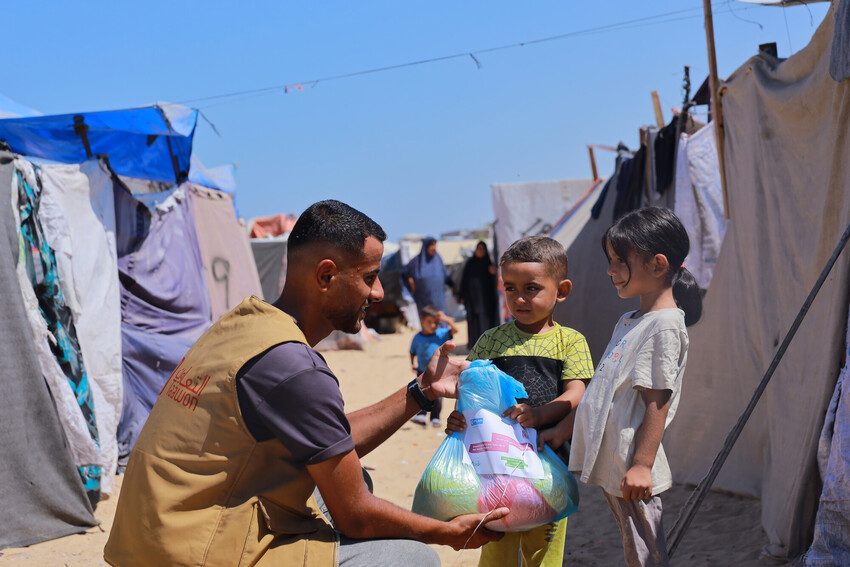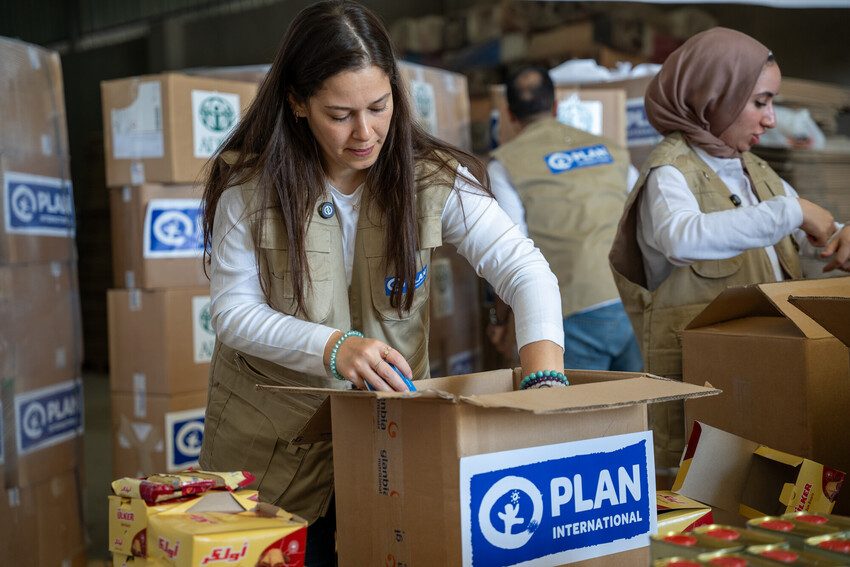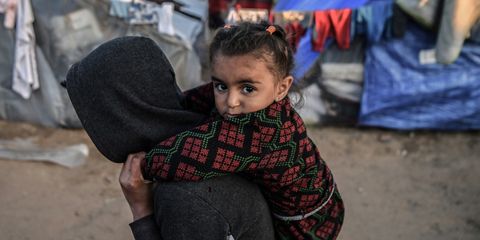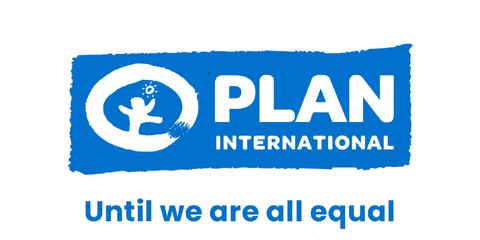Frequently asked questions about the growing humanitarian crisis in Gaza.
This explainer describes the situation in Gaza, the critical need for humanitarian access and aid, and Plan International’s response.

What is the humanitarian situation in Gaza?
Gaza has been described as, “the most dangerous place in the world to be a child,” by UNICEF.
More than 44,786 people have been killed in Gaza and 106,188 have been injured (as of December 2024). The death toll is feared to be much higher as many bodies have not been recovered that are under rubble or in mass graves.
Some 70% of fatalities in Gaza are women and children. Although the number of children who have been killed is not reported frequently, the latest estimate from the Palestinian Ministry of Health surpasses 19,000.
90% of Gaza’s population (1.9 million people) are internally displaced, with decimated livelihoods, crippled food systems, 70% of crop fields destroyed, severely restricted humanitarian operations and the collapse of health services and water, sanitation and hygiene systems.
There is currently a risk of famine across all of Gaza.
What kind of aid is needed in Gaza?
With 1.9 million people displaced in Gaza uprooted from their homes, secure shelter and essential services are in desperately short supply. Humanitarian aid must be inclusive, addressing the needs of people with disabilities and ensuring no one is left behind.
As Gaza braces for the winter, the precarious conditions threaten the well-being of its most vulnerable—women and children, who disproportionately suffer in cold environments due to inadequate shelter. The cold intensifies the suffering of displaced families, especially children and the elderly, who are most vulnerable to the harsh conditions.
Plan International urgently calls for international mobilisation to provide support for the coming winter, including durable shelter, heating solutions, essential winter supplies, warm clothing and robust shelters, especially as the majority of houses in Gaza have been destroyed or damaged.
1.84 million people across the Gaza Strip are experiencing high levels of acute food insecurity classified in IPC Phase 3 (crisis) or above. Of these, 133,000 people are facing catastrophic food insecurity (IPC Phase 5) and 664,000 are in IPC Phase 4 (emergency).
Immediate global intervention is required to prevent a catastrophic famine. It’s not too late to take action to prevent more children from dying.
What is the situation like for children in Gaza?
More children have been killed in Gaza than in all other conflicts combined in the last four years. Those who survive are constantly being exposed to highly traumatic events which will leaving mental and physical scars for years to come.
All children have the right to a life free from violence and fear and it is the collective responsibility of the global community to protect that right.
There are 658,000 students with no access to formal education and nearly nine in 10 (87%) of schools are damaged or destroyed. Immediate action is needed to restore education facilities.
Plan International demands immediate action to ensure resuming safe and inclusive education for all children. We condemn attacks against education, a grave violation of children’s rights in conflict.
Growing up in a warzone, children and young people in Gaza have witnessed repeated devastation that has robbed them of the stability needed to foster their potential. The current situation calls for more than traditional aid; it demands a focused, international effort to rebuild not just infrastructure, but the very hopes and futures of these young individuals.
We cannot afford to lose another generation. It is imperative that we act decisively to restore the dreams and futures of Gaza’s youth, providing them with the tools and opportunities necessary to forge a brighter, peaceful future. Their resilience is our responsibility.
Are people in Gaza able to leave?
1.9 million civilians are currently trapped in Gaza, unable to leave.
With over 100,000 people injured and many facing complex medical conditions, there must be safe passage for these people to seek medical care in well-equipped specialist hospitals outside of Gaza. Anyone who leaves Gaza must be guaranteed the right of return.
How is Plan International responding in Gaza?
Since the escalation of hostilities in October 2023, Plan International Egypt and Jordan have been working with local partners to deliver humanitarian assistance inside Gaza, while advocating for the protection of civilians and unhindered, safe humanitarian access and an end to the targeting of humanitarian aid and workers.

Local partners include the Egyptian Red Crescent (ERC), Mercy Corps, ActionAid, Adventist Development and Relief Agency (ADRA) International and Ma’an, a well-established Palestinian civil society organization (CSO) operating in Gaza.
Humanitarian assistance delivered through local partners as of December 2024 includes food baskets, water, first aid kits, hygiene kits (including towels, soap and toothpaste) and dignity kits (including sanitary pads, underwear and socks.)
Plan International Jordan in collaboration with local partners inside Gaza are addressing key issues such as child protection, food security, and shelter. MoUs have been signed with Terre Des Hommes (TDH) Palestine, Taawon (a welfare organisation in Gaza) and Juzoor.
Humanitarian assistance delivered through local partners as of December 2024 includes over 34,000 hot meals distributed to families and children, multi-purpose cash assistance and winter kits which include blankets and sets of winter clothing.
What has the International Court of Justice (ICJ) ruled about the occupation of Gaza?
The landmark ruling of 19 July 2024 declared that Israel’s occupation of the Gaza strip and the West Bank, including East Jerusalem, is unlawful, along with the associated settlement regime, annexation and use of natural resources.
The Court added that Israel’s legislation and measures violate the international prohibition on racial segregation and apartheid. The ICJ mandated Israel to end its occupation, dismantle its settlements, provide full reparations to Palestinian victims and facilitate the return of displaced people.
When will the war in Gaza end?
The international community has a moral and legal obligation to stop this devastation. Plan International continues to call for a complete, immediate and unconditional ceasefire.
We must also prevent the further transfer of arms that contribute to the conflict and urgently ensure safe, consistent, and unhindered access for humanitarian aid. This is a fundamental right for the people of Gaza, who have been cut off from essential resources, including food, medicine, clean water, and educational materials.
We urge the international community to meet its obligations in ending the root causes of violence by working towards a political settlement in accordance with the UN resolution by ending the unlawful occupation of Gaza and the Westbank, including East Jerusalem. States must also use all bilateral tools at their disposal to directly pressure parties to the conflict into a sustained unconditional ceasefire.
Download the Humanitarian Access Snapshot
Humanitarian Access Snapshot #11 – 19 Jan -15 April 2025
19.87 mb
Humanitarian Access Snapshot #10- West Bank Jan – Feb 2025
22.74 mb
Gaza Humanitarian Access Snapshot #9 – Jan 2025
14.91 mb
Gaza Humanitarian Access Snapshot #8 – Nov 13 – Dec 10
2.55 mb


